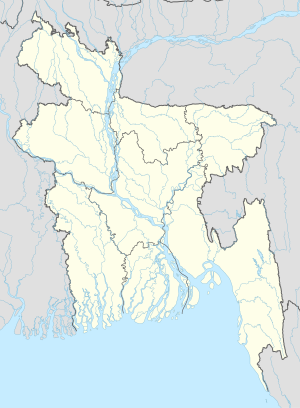Andar Char
Andar Char | |
|---|---|
| Coordinates: 22°52′N 90°31′E / 22.867°N 90.517°E | |
| Country | |
| Division | Barisal Division |
| District | Patuakhali District |
| Upazila | Galachipa |
| Union council | Char Montaz |
| Population (2011)[1] | |
| • Total | 1,609 |
| Time zone | UTC+6 (Bangladesh Time) |
Andar Char is a village in Patuakhali District in the Barisal Division of southern-central Bangladesh.[2] It is a char, i.e. an island formed by the continuous shifting of the river, located in the western Bay of Bengal.[3] It forms a mauza along with the village of Kabiraj Para.[1] As of 2011, the village's population is 1,609 people, in 348 households.[1]
On 7 May 2003, Andar Char was the site of a pirate attack against 27 fishing trawlers.[4] The boats were in the bay when they were boarded by armed pirates, and the fishermen involved lost their catch, their nets, and other valuables.[4] 11 fishermen who attempted to resist were thrown overboard; 7 of them drowned and the other 4 were rescued by other fishermen.[4]
Demographics[edit]
According to the 2011 Bangladesh census, Andar Char has a population of 1,609 people, in 348 households, with an average household size of 4.6 people.[1] The population includes 830 males and 779 females, with a corresponding sex ratio of 107.[1] The village's literacy rate is 63.9%, including 63.8% among males and 64.1% among females.[1] 1,589 of the village's residents are Muslim and 20 are Hindu.[1] A total of 42.0% of the village's residents are age 0 through 19.[1] The village has a total workforce of 99 people, including 93 men and 6 women; all the women and all but two of the men are employed in agriculture.[1] The remaining two men are employed in the service sector.[1] In addition, 76 women were counted as primarily engaged in household work.[1]
Of the village's 348 households, a majority (67.2%) are kutcha structures, with another 28.7% being jhupri and the remaining 4.0% being semi-pucca (none were fully pucca).[1] 21.8% of households had sanitary toilets with water seal, 47.4% had sanitary toilets with no water seal, 26.1% had non-sanitary toilets, and the remaining 4.6% had no toilets.[1] All households obtained drinking water via tube well, and likewise all households were owned instead of rented.[1]
References[edit]
- ^ a b c d e f g h i j k l m n Population & Housing Census 2011 Community Report: Patuakhali (PDF). Bangladesh Bureau of Statistics. 2013. pp. 50, 80, 110, 140, 170, 200, 230, 260, 295, 327, 362, 392, 422. Retrieved 6 July 2021.
- ^ "NGA GeoNames Database". National Geospatial-Intelligence Agency. Retrieved 2008-07-14.
- ^ Shamsuddoha, Md.; Hossain, M. Shahadat; Shahjahan, Mohammad (2014). "Land availability for climate-displaced communities in Bangladesh" (Web). In Leckie, Scott (ed.). Land Solutions for Climate Displacement. Routledge. pp. 138–41. ISBN 978-0-203-76251-6. Retrieved 6 July 2021.
- ^ a b c Menefee, Samuel Pyeatt (2011). "Piracy in Bangladesh: What Lies Beneath?". In Ellerman, Bruce A.; Forbes, Andrew; Rosenberg, David (eds.). Piracy and Maritime Crime (Web). Newport: Naval War College Press. p. 127. ISBN 978-1-884733-65-9. Retrieved 6 July 2021.
External links[edit]

